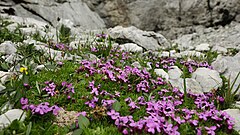Arctic–alpine
An Arctic–alpine taxon is one whose natural distribution includes the Arctic and more southerly mountain ranges, particularly the Alps.[1] The presence of identical or similar taxa in both the tundra of the far north, and high mountain ranges much further south is testament to the similar environmental conditions found in the two locations. Arctic–alpine plants, for instance, must be adapted to the low temperatures, extremes of temperature, strong winds and short growing season; they are therefore typically low-growing and often form mats or cushions to reduce water loss through evapotranspiration.[2]
It is often assumed that an organism which currently has an Arctic–alpine distribution was, during colder periods of the Earth's history (such as during the Pleistocene glaciations), widespread across the area between the Arctic and the Alps. This is known from pollen records to be true for Dryas octopetala, for instance. In other cases, the disjunct distribution may be the result of long-distance dispersal.
Examples of Arctic–alpine plants include:
- Arabis alpina[1]
- Betula nana[3]
- Draba incana[3]
- Dryas octopetala[3][4]
- Gagea serotina (syn. Lloydia serotina)[5]
- Loiseleuria procumbens[6]
- Micranthes stellaris[7]
- Oxyria digyna[3]
- Ranunculus glacialis[1]
- Salix herbacea[3]
- Saussurea alpina[3]
- Saxifraga oppositifolia[3]
- Silene acaulis[8]
- Thalictrum alpinum[3]
- Veronica alpina[1]
References
- ^ a b c d Thomas Schmitt, Christoph Muster; Peter Schönswetter (2009). "Are disjunct alpine and arctic–alpine animal and plant species in the Western Palearctic really "relics of a cold past"?". In Jan Christian Habel, Thorsten Assmann (ed.). Relict Species: Phylogeography and Conservation Biology. Springer. pp. 239–252. ISBN 9783540921608.
- ^ Heather Pardoe (1995). Mountain Plants of the British Isles. National Museums and Galleries of Wales. ISBN 0-7200-0423-3.
- ^ a b c d e f g h Harry Godwin (1956). The History of the British Flora: a Factual Basis for Phytogeography. Cambridge University Press. p. 444.
- ^ Inger Skrede; Pernille Bronken Eidesen; Rosalía Piñeiro Portela; Christian Brochmann (2006). "Refugia, differentiation and postglacial migration in arctic-alpine Eurasia, exemplified by the mountain avens (Dryas octopetala L.)". Molecular Ecology. 15 (7): 1827–1840. doi:10.1111/j.1365-294X.2006.02908.x. PMID 16689901.
- ^ Barbara Jones; C. Gliddon (1999). "Reproductive biology and genetic structure in Lloydia serotina". Plant Ecology. 141 (1–2): 151–161. doi:10.1023/A:1009805401483.
- ^ Hajime Ikeda; Kei Denni; Noriyuki Fujii; Hiroaki Setoguchi (2009). "High mountains of the Japanese archipelago as refugia for arctic–alpine plants: phylogeography of Loiseleuria procumbens (L.) Desvaux (Ericaceae)". Biological Journal of the Linnean Society. 97 (2): 403–412. doi:10.1111/j.1095-8312.2009.01177.x.
- ^ Norman Dignard (2006). "Micranthes stellaris (Saxifragaceae), new to Québec". Rhodora. 108 (933): 72–75. doi:10.3119/05-13.1.
- ^ S. R. Hagen; G. G. Spomer (1989). "Hormonal regulation of growth form in the Arctic–Alpine cushion plant, Silene acaulis". Arctic and Alpine Research. 21 (2): 163–168. JSTOR 1551628.




